Delicious Delhi
- By Katharine
- 25 February, 2014
- 1 Comment
Delhi has proven fascinating and not as overwhelming as I’d expected. I hired a taxi through the hotel on Monday and went to see the Purana Qila (Old Fort), the circumference of which is 1.9 kilometers. The walls are about 17 feet thick and the gates are massive and beautifully ornamented. The forts here were really much more than military installations: They were walled cities, complete with palaces and mosques inside. This one is the subject of an ongoing archaeological dig, and it contains a small archaeological museum with 7 glass cases: one for each period of Delhi’s settlement, beginning with the earliest chipped stone spear points and ending with the Mughal Empire.
I wandered around for an hour and a half, skirting most of the wall and climbing up on one for a view of what used to be the Yamuna River. The river has long since changed course, and the former riverbed is now a ring road. Inside the grounds were lovely and uncrowded — really like a park, and as with other parks I visited, it seemed to be mostly frequented by young Indian couples, who sat on the grass or caressed each other behind arches and pillars, very discreetly by Western standards.
Next I visited the Hanuman Temple near Connaught Place. I’d expected to see the one with a giant, 108-foot statue of the monkey god. I saw that today instead, from inside a taxi. But the small one I visited turned out to be the oldest Hindu temple in Delhi. I took off my shoes, covered my head, and walked inside to see people lining up to say prayers and offer flower garlands before a statue of Hanuman. Eventually, a swami beckoned me forward and handed me a small dish of ghee (clarified butter) and a banana and put a red mark on my forehead. I didn’t eat the “prasad,” or blessed food, being a bit paranoid about “Delhi Belly,” but enjoyed the music, the smell of incense, and beautiful statues of all the major Hindu deities, including one with 5 heads and one of Ganesh, the elephant god. I was the only Westerner in the temple.
My taxi driver then gave me a tour that included the beautiful and massive India gate, which sits at one end of a park that looks much like the mall in Washington, with some beautiful and massive government buildings at the other end, including the Parliament building and the Presidential Palace. Then, instead of taking me to a restaurant and government run craft market near Connaught Place, as I’d requested, he did the typical thing — took me to a restaurant and Indian craft emporium where he would get a kickback. I did end up buying an absolutely exquisite, embroidered Pashtush shawl, and bargaining the price down by 40 percent. I also had an excellent lunch — the best palak paneer I’ve ever eaten.
Finally, he drove me to Connaught Place, which is THE luxury shopping center of Delhi. As soon as we entered the inner circle, I spotted a Dunkin Donuts, a McDonalds, and a KFC — at which point I said forget it and pointed to a “sight” marked on my Lonely Planet map of Delhi, called Jantar Mantar, having no idea what it was. It turned out to be the most amazing astronomical observatory: all physical structures, including a massive sundial; an international clock with curved surfaces, each with a precise scale of 180 degrees on it, that tells the time in Greenwich, England, Singapore, Japan, and India (if I remember correctly); two huge circles of pillars that look kind of like Stonehenge, one a sun calendar circle and the other a moon calendar; another series of oddly but beautifully angled white curves that somehow tell the astrological sign and degree of the sun; and a dark chamber with a pinhole in it. My impromptu guide told me his grandfather had been in charge of it and his father had given Stephen Hawking a tour.
I met my tour group back at the hotel: lots of Brits, two New Zealanders, a couple of Americans, a Chilean (married to one of the Americans), and a Brazilian who lives in the United States. They are all very nice, as is our tour leader, who took us to an excellent local restaurant last night and tonight.
This morning we took the Metro to Old Delhi, where the roads are much smaller. We visited the Jama Masjid, an enormous and famous mosque, and a Sikh Temple, traveling a few blocks from one to the other by bicycle rickshaw. We had to take off our socks and shoes and walk through a shallow basin of water before entering the Sikh Temple. Afterward, we toured the attached communal kitchen. The Sikhs feed 8,000 people a day — for free, as an act of pious charity. We stopped at a special snack bar afterward, where I had an amazing, puffy fried shell filled with sweet yogurt and drizzled with spicy coriander sauce, tamarind sauce, and roasted chickpeas, with a couple of other surprises hidden inside. That and a cheese cutlet and a samosa ended up being lunch. Afterwards, we visited one store in a huge spice market. Needless to say, I bought a few packets to bring home.
Our tour leader headed back to the hotel, but a bunch of us went by tuk-tuk to the Red Fort, which with a perimeter of more than 2 kilometers is even bigger than the Purana Qila. This one contained several palaces, an inner gate where people once parked their elephants, and a huge, arched audience hall with beautiful lotus-ornamented arches. After entering the first, outer gate, you walk through a covered market, which now sells souvenirs and Indian handcrafts, but where vendors once sold fine silks and gems. The fort contains two museums: one about India’s independence struggle, and one with artifacts from the Mughal Empire; one of the last emperors built this walled royal city. There were also a mosque, a bathhouse, a step well, and a formal garden with four shallow waterways (now dry) representing the four rivers of Paradise in the Koran: a river of purest water, one of milk that never changes its flavor, one of wine, and one of golden honey. In the center is a red sandstone platform in the middle of a fountain, where musicians would play, and at the ends of two of the waterways are arched marble buildings, open on three sides, where the royals could sit during the monsoons to watch the rain.
One of the funniest things that happened was many Indian people wanted their photos taken with us — especially two younger Englishwomen who walked around the Red Fort with me and another solo woman traveler around my age. We spotted one young woman in a beautiful red sari with henna patterns on her hands, 3 inches of bangles up her wrist, and holding hands with a young man wearing a Nehru-style jacket. They were on their honeymoon, and they allowed us to take their picture. They were touchingly sweet with one another. We all had an “Awww” moment.
One last note: Delhi traffic is an experience all by itself. Lane lines, even on the highways, are a hint that Indian drivers are reluctant to take. I have seen a turn signal used exactly once. Two small cars will share a lane, with bicycles and scooters scooting in between. Buses share the roads with small trucks, auto-rickshaws, bicycle rickshaws, the occasional horse-drawn carriage (like those in Central Park,these seem to be used for romantic rides rather than real transport), tuk-tuks, the occasional bullock cart, and pedestrians. Except on the major arteries, everyone walks in the street, even where there are sidewalks. Every intersection or traffic jam is a game of chicken, with collisions avoided by inches about 100 times an hour. And yet somehow it all works, which is to say that I’m not dead yet.
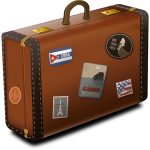
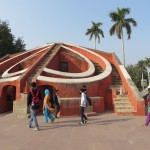
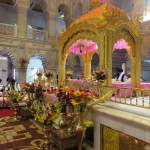
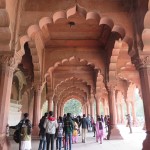
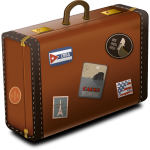 Copyright © 2025
Copyright © 2025
I loved this — it’s bringing back a lot of memories! I miss the tuk-tuks, crazy drivers and delicious butter chicken. We also got a lot of photo requests. A lot of people just followed us around with their cameras and phones!